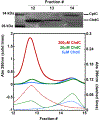Control of Metabolite Flux during the Final Steps of Heme b Biosynthesis in Gram-Positive Bacteria
- PMID: 31241911
- PMCID: PMC7160669
- DOI: 10.1021/acs.biochem.9b00140
Control of Metabolite Flux during the Final Steps of Heme b Biosynthesis in Gram-Positive Bacteria
Abstract
The pathway for assembling heme ends with a unique set of enzymes in Gram-positive bacteria. Substrates for these reactions include coproporphyrin III, Fe(II), and H2O2, which are highly reactive and toxic. Because these bacteria lack membranous compartments, we hypothesized that metabolite flux may occur via a transient protein-protein interaction between the final two pathway enzymes, coproporphyrin ferrochelatase (CpfC) and coproheme decarboxylase (ChdC). This hypothesis was tested using enzymes from the pathogen Staphylococcus aureus and a corresponding ΔchdC knockout strain. The ultraviolet-visible spectral features of coproporphyrin III served as an in vitro indicator of a protein-protein interaction. A CpfC-ChdC KD of 17 ± 7 μM was determined, consistent with transient complexation and supported by the observation that the catalytic competence of both enzymes was moderately suppressed in the stable complex. The ΔchdC S. aureus was transformed with plasmids containing single-amino acid mutants in the active site gate of ChdC. The porphyrin content and growth phenotypes of these mutants showed that K129 and Y133 promote the ChdC-CpfC interaction and revealed the importance of E120. Understanding the nature of interactions between these enzymes and those further upstream in the heme biosynthesis pathway could provide new means of specifically targeting pathogenic Gram-positive bacteria such as S. aureus.
Conflict of interest statement
The authors declare no competing financial interest.
Figures











Similar articles
-
Crystal structures and calorimetry reveal catalytically relevant binding mode of coproporphyrin and coproheme in coproporphyrin ferrochelatase.FEBS J. 2020 Jul;287(13):2779-2796. doi: 10.1111/febs.15164. Epub 2019 Dec 19. FEBS J. 2020. PMID: 31794133 Free PMC article.
-
Staphylococcus aureus haem biosynthesis: characterisation of the enzymes involved in final steps of the pathway.Mol Microbiol. 2015 Aug;97(3):472-87. doi: 10.1111/mmi.13041. Epub 2015 May 26. Mol Microbiol. 2015. PMID: 25908396
-
The chlorite dismutase (HemQ) from Staphylococcus aureus has a redox-sensitive heme and is associated with the small colony variant phenotype.J Biol Chem. 2013 Aug 9;288(32):23488-504. doi: 10.1074/jbc.M112.442335. Epub 2013 Jun 4. J Biol Chem. 2013. PMID: 23737523 Free PMC article.
-
HemQ: An iron-coproporphyrin oxidative decarboxylase for protoheme synthesis in Firmicutes and Actinobacteria.Arch Biochem Biophys. 2015 May 15;574:27-35. doi: 10.1016/j.abb.2015.02.017. Epub 2015 Feb 21. Arch Biochem Biophys. 2015. PMID: 25711532 Free PMC article. Review.
-
Prokaryotic Heme Biosynthesis: Multiple Pathways to a Common Essential Product.Microbiol Mol Biol Rev. 2017 Jan 25;81(1):e00048-16. doi: 10.1128/MMBR.00048-16. Print 2017 Mar. Microbiol Mol Biol Rev. 2017. PMID: 28123057 Free PMC article. Review.
Cited by
-
Efficient De Novo Biosynthesis of Heme by Membrane Engineering in Escherichia coli.Int J Mol Sci. 2022 Dec 8;23(24):15524. doi: 10.3390/ijms232415524. Int J Mol Sci. 2022. PMID: 36555164 Free PMC article.
-
Reactivity of Coproheme Decarboxylase with Monovinyl, Monopropionate Deuteroheme.Biomolecules. 2023 Jun 6;13(6):946. doi: 10.3390/biom13060946. Biomolecules. 2023. PMID: 37371526 Free PMC article.
-
Active site architecture of coproporphyrin ferrochelatase with its physiological substrate coproporphyrin III: Propionate interactions and porphyrin core deformation.Protein Sci. 2023 Jan;32(1):e4534. doi: 10.1002/pro.4534. Protein Sci. 2023. PMID: 36479958 Free PMC article.
-
Structural aspects of enzymes involved in prokaryotic Gram-positive heme biosynthesis.Comput Struct Biotechnol J. 2023 Jul 24;21:3933-3945. doi: 10.1016/j.csbj.2023.07.024. eCollection 2023. Comput Struct Biotechnol J. 2023. PMID: 37593721 Free PMC article. Review.
-
Regulation of heme biosynthesis via the coproporphyrin dependent pathway in bacteria.Front Microbiol. 2024 Mar 21;15:1345389. doi: 10.3389/fmicb.2024.1345389. eCollection 2024. Front Microbiol. 2024. PMID: 38577681 Free PMC article. Review.
References
-
- Gillam ME, Hunter GA, and Ferreira GC (2013) The Ultimate Step of Heme Biosynthesis: Orchestration Between Iron Trafficking an dPorphyrin Synthesis In Handbook of Porphyrin Science, pp 130–174, EBCO Publishing.
-
- Ferreira GC, Andrew TL, Karr SW, and Dailey HA (1988) Organization of the terminal two enzymes of the heme biosynthetic pathway. Orientation of protoporphyrinogen oxidase and evidence for a membrane complex. J. Biol. Chem 263, 3835–3839. - PubMed
Publication types
MeSH terms
Substances
Grants and funding
LinkOut - more resources
Full Text Sources
Miscellaneous

